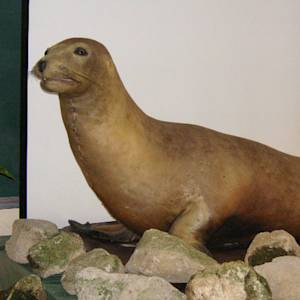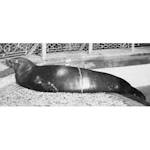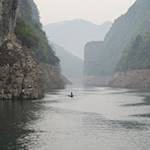Steller's Sea Cow Extinct
circa 1768 CE • Commander Islands / North Pacific
"When Commander Vitus Bering's ship St. Peter was wrecked on a remote, rocky island in 1741, the survive crew members found, in addition to bewhiskered sea otters, immense 'sea cows,' which were subsequently named for Bering's naturalist, Georg Wilhelm Steller. . . Steller's biographer. . . estimated that there were about 1,500. . . The animal, which could probably not dive below the surface, pulled itself along the shallows on its stumps as it browsed on kelp. Instead of teeth, the mouth of the sea cow was equipped with horny plates that it rubbed together to grind plant matter into a pulp. . . The sealers killed the huge, slow moving, oil-rich 'manatees' with such insensitive profligacy that there were none left by 1768."
Ellis, Richard. No Turning Back: the Life and Death of Animal Species. New York, NY: HarperCollins, 2004. 132-133.
Steller's Sea Cow. Digital image. Extinct Monsters London :Chapman & Hall,1896. Web. <https://commons.wikimedia.org/wiki/File:Steller%27s_Sea_Cow.jpg>.


Learn about Maya Lin’s fifth and final memorial: a multi-platform science based artwork that presents an ecological history of our world - past, present, and future.

Discover ecological histories and stories of former abundance, loss, and recovery on the map of memory.

Learn how we can reduce our emissions and protect and restore species and habitats – around the world.

See how art can help us rethink the problems we face, and give us hope that each one of us can make a difference.

Help make a global memorial something personal and close to home. Share your stories of the natural world.


